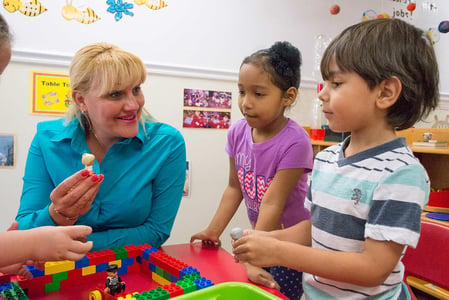
At a CLASS Group Coaching (MMCI) Training in Florida, an instructor told a story about finding a coconut on the beach with her granddaughter. She asked her, “How do you think we can open it up?” Before her grandchild could respond, her husband chimed in with exact instructions. She laughed because of course she had been trying to get her granddaughter problem solving—not her husband! It’s so easy and natural for us to jump in with an answer. As teachers, we have to remind ourselves why we stand back—to give children the opportunity to build those higher-order thinking skills that are so important to school and life success.
Too frequently we confuse providing information with promoting higher-order thinking. Providing information tells a child facts and knowledge about a subject. It’s not wrong—children do need to know their colors, shapes, and numbers—but it doesn’t challenge a child to do anything more than memorize, especially when those facts are isolated from anything the child is doing. To build thinking skills, children need to use that information to make sense of the world around them, or, even better, learn those facts within the context of exploring the world.
Appropriate opportunities to promote higher-order thinking include:
- Asking children how or why something works: “How did you make your tower so strong and tall?” “Why does this balloon float to the ceiling, but this one sinks to the floor?”
- Setting up experiments to test ideas: “Which ice cube will melt the fastest? One in the classroom or one outside? Let’s try it and find out!”
- Comparing and classifying items: “Look—we’ve got all this food mixed up in our housekeeping area. We’ve got three little baskets. How can we sort out all the food?”
- Providing opportunities to be creative: “You want to build a new marble run? What’ll it look like? What else do you need to build it? Go for it!”
I’m always surprised by how children answer; they show me so much about how they see the world. For example, they might sort the foods into “yummy” “icky” and “weird” baskets or say that their tower is strong because they used the blue blocks. This provides plenty of opportunities for me to respond in ways that help them understand concepts a little better (“Why are blue blocks stronger? Could you make a strong tower with the red blocks, too? How?”). Just think, if I’d told them how to sort the food—they would have done so, and done fine, but neither of us would have learned anything about how to think. Now that I know they see food in those categories, I might ask them to subdivide their categories or challenge their choices (“Hmmmm. I see you put tomatoes in your “icky” basket, but I know you like pizza and spaghetti. Those are made with tomatoes. I wonder why you like those tomatoes and not these?”).
For me, it’s endlessly fascinating to see how children think and help them understand how to make sense of the world. Does this engage you in your work with children? I’d love to hear your stories!

